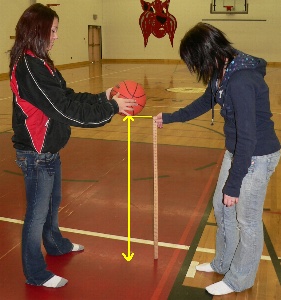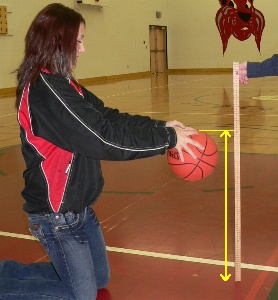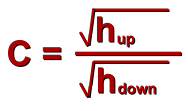  A basketball that is to be used for an official game has to have just the right 'bounciness' ... it must bounce back up by a certain amount to be considered acceptable for game play.
A basketball that is to be used for an official game has to have just the right 'bounciness' ... it must bounce back up by a certain amount to be considered acceptable for game play. There are a variety of ways to measure a basketball's bounce; we'll show you one way here that uses nothing more complicated than a metre stick and the use of square roots and a calculator. In order to measure a ball's bounce, you must drop it from a measured distance, and then record the distance to which it rises after it bounces. Since the surface you bounce it on will also affect how high it bounces, you should do the test on a basketball court floor. We tested a variety of basketballs, some in good condition and some not so good. We'll show you how to make the calculation. First you must measure the distance that the ball falls. We'll call this the height down, or hdown. This is measured from the bottom of the basketball to the floor, as shown in the picture at the left below. Next, measure the distance that the ball rises after bouncing. We'll call this the height up, or hup. This is measured from the floor to the top of the basketball, as shown in the picture at the right below. (The person doing this had her hands ready to catch the ball at the top of its rise, to make measuring easier) 
 Here's the formula for calculating the bounciness of the basketball. Bounciness is referred to as the coefficient of restitution, and we'll call it C.  We did the experiment a number of times, on a variety of balls. Here is one result we got: for a drop of 100 cm, the ball bounced back up to 61 cm (measured to the top of the ball). Let's work out the coefficient of restitution for this ball: 
According to one source we found, an official basketball should have a coefficient of restitution of between 0.76 and 0.80, so the ball shown above was a good one. Surprisingly, some of the balls had a value of C that was higher than 0.80; we couldn't find an explanation for why a ball that is too bouncy could not be an official ball. 

 |